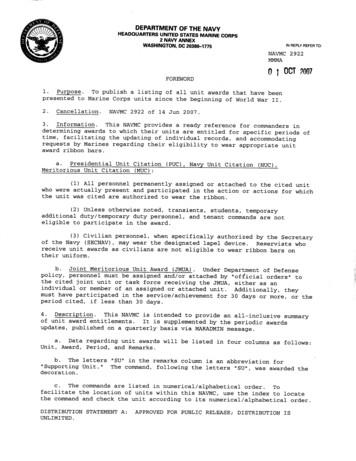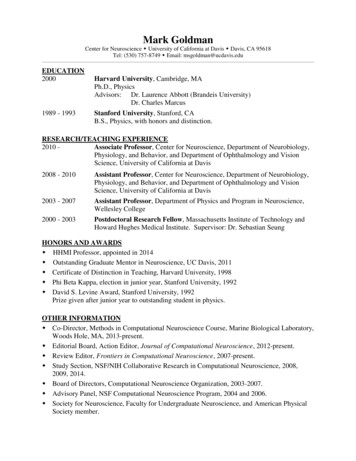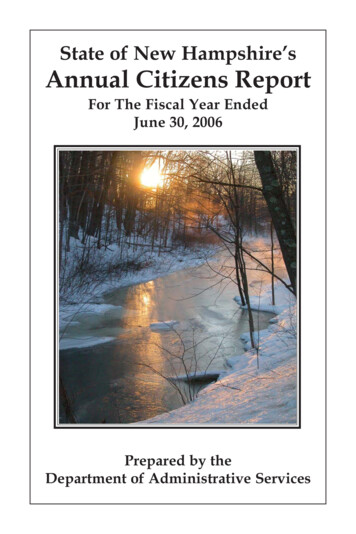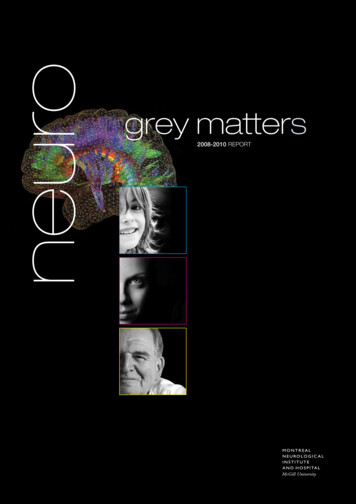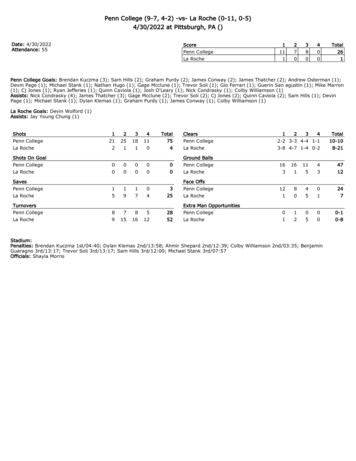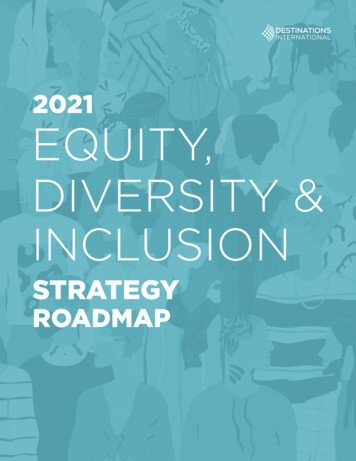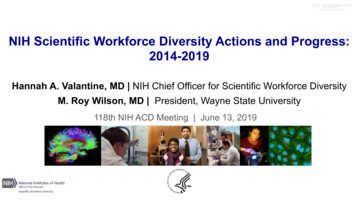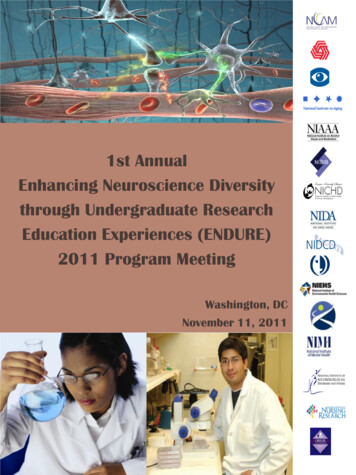
Transcription
1st AnnualEnhancing Neuroscience Diversitythrough Undergraduate ResearchEducation Experiences (ENDURE)2011 Program MeetingWashington, DCNovember 11, 2011
TABLE OF CONTENTSENDURE PROGRAM AND MEETING GOALS2ENDURE MEETING AGENDA3BIOGRAPHICAL SKETCHES - PANEL SPEAKERS5MENTORING RESOURCES AND PROFESSIONAL CONFERENCES8EDURE TRAINEE INFORMATION AND RESEARCH ABSTRACTS9 BP-ENDURE-ATLANTA: ENGAGING UNDERGRADUATES IN NEUROSCIENCE RESEARCH9 BP-HUNTER COLLEGE21 BUILDING RESEARCH ACHIEVEMENT IN NEUROSCIENCE (BRAIN)34 SOUTH TEXAS ADVANCED RESEARCH TRAINING: UNDERGRADUATE PROGRAM (START-UP)46 NEUROSCIENCE RESEARCH OPPORTUNITIES TO INCREASE DIVERSITY (NEUROID)51ENDURE COMPLETE ACTIVITIES AT SFN60PARTICIPANT LIST62NOTES651
ENDURE PROGRAM GOALSThe Blueprint initiative "Enhancing Neuroscience Diversity through Undergraduate ResearchEducation Experiences (ENDURE)" aims to raise interest and opportunities in neuroscienceresearch for individuals who are typically underrepresented in the neuroscience. The goal isto provide such individuals with training at the undergraduate level, so that they areprepared to enter and successfully complete neuroscience Ph.D. programs. ENDUREprovides undergraduate training through partnerships between research-intensiveinstitutions and institutions with a substantial enrollment of neuroscience majors fromdiverse groups. This includes individuals from underrepresented racial and ethnic groups;individuals with disabilities; and individuals from economically disadvantaged backgrounds.ENDURE undergraduate training programs support a range of activities to increase studentinterest and involvement in the neurosciences, including research experiences, core andadvanced neuroscience courses, seminars, and journal clubs. In FY 10, five ENDURE awardswere granted.MEETING GOALSAs issued, the RFA MH-10-070.html ) cites“it is a goal of this initiative that the NIH Blueprint Institutes will convene an annual meetingthat will bring together BP-ENDURE program directors and participating students”. Thepurpose of the meeting will be to discuss best practices and provide a forum for studentscientific and academic enhancing activities. An additional goal and outcome for this annualmeeting is to provide linkage and opportunity for collaboration for existing diversity (exampleNeuroscience Scholars Program) and undergraduate (example Faculty for UndergraduateNeuroscience) programs already at Society for Neuroscience. The students will enhancetheir networks with other ENDURE participants, peer mentoring from diverse graduatestudents, and T32 program directors.THE ORGANIZING COMMITTEEDr. Michelle Jones-LondonDr. Mark ChavezDr. Alberto Rivera-rentasMs. Christiana RobbinsMs. Lynn MorinMs. Theresa TolbertThe Dixon Group, Inc. StaffMs. Nicole ChapmanMs. Nakia WilsonMrs. Josette PaigeFor further information about the program and its training sites:http://neuroscienceblueprint.nih.gov/bp nih-supported training/endure programs.htm2
1ST ANNUAL ENHANCING NEUROSCIENCE DIVERSITY THROUGH UNDERGRADUATERESEARCH EDUCATION EXPERIENCES (ENDURE) 2011 PROGRAM MEETINGNOVEMBER 11, 2011GRAND HYATT HOTEL, WASHINGTON, DC * INDEPENDENCE BALLROOM EAGENDA2:30 – 3:00 pmREGISTRATION3:00 – 3:05 pmMEETING GOALS AND INTRODUCTIONDr. Michelle Jones-London, Office of Training, Career Development andWorkforce Diversity, National Institute for Neurological Disorders andStroke (NINDS)3:05 – 3:15 pmNIH BLUEPRINT WELCOMEDr. Story Landis, NINDS Director3:15 – 3:45 pmENDURE UNDERGRADUATE TRAINING COMMUNITY OVERVIEW(R25 PIs state program name, focus and identify areas of interest forcollaboration) Georgia State University, Atlanta - Dr. Kyle J. FrantzPartner institutions: Emory University, Agnes Scott College and Spelman College Hunter College, New York- Dr. Vanya Quinones-JenabPartner Institution: New York University University of Colorado, Denver - Dr. Diego RestrepoPartner Institution: New Mexico State University University of Texas Health Science Center, San Antonio - Dr. Alan FrazerPartner Institutions: University of Texas, San Antonio; Lady of the Lake University;St. Mary’s University; Trinity University; and University of the Incarnate Word University of Puerto Rico, Rio Piedras - Dr. Jose Garcia-ArrarasPartner Institutions: Inter-American University of Puerto Rico, Bayamon Campusand Universidad el Este3
4:00 – 5:15 pmPATHWAYS AND PERSPECTIVES ON BEING A RESEARCHERCHAIR AND PANEL INTRODUCTIONS: Dr. Mark Chavez, Division of AdultTranslational Research and Treatment Development, National Instituteof Mental Health (NIMH)A discussion framed by several specific questions: What a graduate student should expectboth of the school and themselves? How to identify a good mentor? Why a career inneuroscience research is fulfilling? How do I prepare for and navigate some of thechallenges of graduate school?Each accomplished researcher will share their research background and answer thegeneral questions from their respective lens including early lessons from junior faculty,being a diverse scientist, and programmatic views and expectations from a T32 Directorand College Dean Farah Lubin, Ph.D. - University of Alabama at Birmingham, Department ofNeurobiology, Assistant Professor Francis Lotrich, M.D., Ph.D. - University of Pittsburgh School of Medicine,Department of Psychiatry, Assistant Professor Kathleen Friel, Ph.D. - Columbia University Medical Center, Division of BrainStimulation and Therapeutic Modulation, Assistant Professor Irwin Lucki, Ph.D. - University of Pennsylvania, Department of Psychiatry,Professor Tuajuanda Jordan, Ph.D. - Lewis and Clark College, Dean of College of Artsand Science5:15 – 5:30 pmOPEN DISCUSSION(Questions from the floor and from note cards)Moderator: Dr. Alberto L. Rivera-Rentas, Minority Biomedical Research Support (MBRS)Branch, National Institute of General Medical Sciences (NIGMS)5:30 – 5:35 pmCLOSING REMARKSDr. Thomas R. Insel, NIMH Director5:35 – 7:00 pmT32 RECRUITMENT FAIR, NETWORKING AND LIGHT RECEPTION4
BIOGRAPHICAL SKETCHES - PANEL SPEAKERSEach accomplished researcher will share their scientific research background andanswer mentoring and general training questions from their respective lens including:early lessons from junior faculty, being a diverse scientist, and programmatic viewsand expectations from a T32 Director and College Dean.Farah D. Lubin, Ph.D.University of Alabama at BirminghamAssistant ProfessorDepartment of NeurobiologyDr. Lubin received her Ph.D. in Cell Molecular immunologyfrom Binghamton University in Binghamton, New York. She hascompleted two postdoctoral fellowships in MolecularNeuroscience at Baylor College of Medicine in Houston, Texasand most recently in the Department of Neurobiology atUAB. Dr. Lubin is a recipient of a Pathway to IndependenceAward from the National Institutes of Health (NIH/NIMH) and FASEB Award. Currently,Dr. Lubin’s research is primarily directed towards identifying transcriptionalmechanisms that serve to regulate gene expression changes necessary for learningand memory. Her lab is focused on characterizing the role of epigenetic mechanismsand signaling cascades that mediate the interaction of transcription factors tochromatin and determine how they participate in the regulation of gene expressionas they relate to learning and memory and memory deficits associated with aging,post-traumatic stress disorder, and epilepsy.Francis E. Lotrich, M.D., Ph.D.University of Pittsburgh School of MedicineAssistant ProfessorDepartment of PsychiatryDr. Lotrich is interested in genetic vulnerability and resilienceto major depression, specifically depression that is directlyrelated to medical illness. In particular, he is conductingresearch on interferon-induced depression in humans andinvestigating the interaction of genes, personality, andcytokine exposure in the etiology of depression. Morebroadly, he is interested in genetic vulnerability to a broad array of potentiallydepression-related hormones and cytokines, including cortisol, estrogen, and TNFalpha. He has similarly been using pharmacogenetic tools to examine geneticinfluences on the efficacy of antidepressant interventions.5
Kathleen Friel, Ph.D.Columbia University Medical CenterAssistant ProfessorDivision of Brain Stimulation and Therapeutic ModulationDr. Kathleen Friel is an Assistant Professor of ClinicalPsychiatry in the Division of Brain Stimulation andTherapeutic Modulation (BSTM). Dr. Friel received her Ph.D.from the University of Kansas Medical Center, studyingneurophysiological correlates of stroke recovery in thelaboratory of Dr. Randolph Nudo. Dr. Friel completed apostdoctoral fellowship in the laboratory of Dr. John Martinat Columbia University. With Dr. Martin, she investigated rehabilitation strategies-and their neural underpinnings-- in an animal model of hemiplegic cerebral palsy(CP). Dr. Friel joined the faculty of the BSTM in July 2008. In the BSTM, she conductstranslational research in children with hemiplegic CP.Irwin Lucki, Ph.D.University of PennsylvaniaProfessorDepartments of Psychiatry and PharmacologyDr. Lucki's ongoing research focuses on the neuralmechanisms associated with anxiety and mood disordersand the behavioral effects of antidepressants andantianxiety drugs, as well as the development of newtherapeutic approaches leading to improved psychiatricmedications for treatment of behavioral disorders. He hasconducted clinical pharmacologic research studies and receives research fundingfrom the National Institutes of Health (NIH), private foundations, and thepharmaceutical industry. Dr. Lucki is Director of the Training Program inNeuropsychopharmacology, a training program composed of over 35 faculty focusedon translational research in Psychiatry supported by the NIH for over 30 years(http://www.med.upenn.edu/npp training/). He is a member of the GraduateGroups in Pharmacological Sciences, Neuroscience and Psychology at the Universityof Pennsylvania. He has mentored over 30 graduate students and postdoctoralfellows.6
Tuajuanda Jordan, Ph.D.Lewis and Clark CollegeDeanCollege of Arts and ScienceDr. Jordan is the Dean of the College at Lewis & Clark Collegein Portland, Oregon. Prior to coming to Lewis & Clark, shewas a director of science education at the Howard HughesMedical Institute where her program, the National GenomicsResearch Initiative, was heralded as a model for scienceeducation. From 1994 – 2005, Dr. Jordan was on the facultyat Xavier University of Louisiana in the chemistry andeventually promoted to the position of associate vice president of academic affairs.Dean Jordan received a B.S. in chemistry from Fisk University and a PhD inbiochemistry from Purdue University. She has served on numerous boards andcommittees focused on diversity, science, and science education. Most recently shewas appointed to the NIH Advisory Committee to the Director Working Group onDiversity in the Biomedical Research Workforce.7
MENTORING RESOURCES AND PROFESSIONAL CONFERENCES"MENTOR: SOMEONE WHOSE HINDSIGHT CAN BECOME YOUR FORESIGHT”Society for Neuroscience Mentoring Programhttp://neuronline.sfn.org/home/How to Get the Mentoring You Want: A Guide for Graduate Students at a Diverse mentoring/mentoring-guide.pdfHow to Mentor Graduate Students: A Guide for GarciaHill: A Virtual Community for Minorities in Scienceshttp://justgarciahill.org/The Leadership Alliancehttp://www.theleadershipalliance.org/NIDA Mentoring ringGuide.pdfPROFESSIONAL CONFERENCESVenues for professional development activities, scientific presentations and networkingopportunities with diverse peers, faculty and academic biomedical research Institutions Association of American Indian Physicians (AAIP) Annual Biomedical Research Conference for Minority Students (ABRCMS) Association of Minority Health Professions Schools, Inc. (AMHPS) Hispanic Association of Colleges and Universities (HACU) Society for the Advancement of Chicanos and Native Americans in Science (SACNAS) Neuroscience Scholars Program (NSP) at Society for Neuroscience8
ENDURE TRAINEE INFORMATION AND RESEARCH ABSTRACTSBP-ENDURE-ATLANTA: ENGAGING UNDERGRADUATESIN NEUROSCIENCE RESEARCHGEORGIA STATE UNIVERSITYPrincipal Investigator: Dr. Kyle J. FrantzPartner Institutions: Emory University, Agnes Scott College and Spelman CollegePROGRAM DESCRIPTION: Undergraduate students can be attracted to science by engagingin research. A summer experience as an apprentice in a scientist's laboratory or clinicmay be effective in this regard, but short-term research may fail to provide thepreparation necessary to progress into PhD programs in fields such as neuroscience.The BP- ENDURE-Atlanta project led by Georgia State University (GSU) in partnershipwith Agnes Scott College (ASC), Emory University, and Spelman College, will provide atwo-year neuroscience research immersion and integration program for students fromunderrepresented groups. Program evaluation will test the hypothesis that in-depthresearch training, coupled with an intensive professional development workshop series,will positively affect participants' communication skills and confidence with researchabilities, and will increase rates of matriculation into neuroscience PhD programs.Identification of a reliable approach to developing the skills and confidence necessaryto progress into PhD programs will enable more students from various backgrounds topursue their interests in science, and will ultimately increase diversity in the USscientific workforce.Specific Aim 1 is to engage undergraduates from underrepresented groups in researchand training, using a two-year program for junior and senior undergraduates thatincludes five major components: 1) a research immersion in Atlanta's well-establishedBRAIN summer program; 2) a Research Assistantship in the first academic year; 3) aTravel Assistantship to conduct research at a partner T32 training program in thesecond summer; 4) a Capstone Research Assistantship during the second academicyear; and 5) an intensive professional development workshop series.Specific Aim 2 is to test the hypothesis that this neuroscience research program willpositively affect scientific communication skills and confidence with research abilitiesamong undergraduates, thereby raising rates of matriculation into neuroscience PhDprograms.By conducting hypothesis-driven science education research, this project will fill a gap incurrent knowledge about how best to encourage and prepare students to help addressbiomedical, behavioral, and clinical research needs, with a focus on students fromunderrepresented groups. By publishing results in peer-reviewed journals targetingdifferent subpopulations in the scientific community, we will extend beyond the norm ofmany training programs in terms of contributing to best practices in science education.9
ENDURE TRAINEE ABSTRACTNAME: MICHELLE AUTREYHome Institution and State: Agnes Scott College, GeorgiaUndergraduate Academic Level: JuniorUndergraduate Major and Expected Graduation Date: Psychology, May 2013Mentors/Advisors at Home Institution: Dr. William HopkinsENDURE TRAINEE SCIENTIFIC INTERESTSMs. Autrey's research interests include cognition and behavior, as well as disorders ofnervous system, development, depression, Alzheimer’s disease, and Post-TraumaticStress Disorder.ENDURE TRAINEE CAREER GOALS AND PLANMs. Autrey's post-baccalaureate plans could include obtaining a Ph.D. in clinicalpsychology and opening a private practice. She wants to able to help any individualsthat need assistance, so she hopes to have a practice that is accessible to individualsfrom all income levels. She would also like to create a foundation to help homelessindividuals. Additionally, she is considering an appointment with either AmeriCorps orthe Peace Corps.ENDURE TRAINEE SUMMER RESEARCH EXPERIENCEENDURE Summer Research Experience Institution: Georgia State UniversityMentors/Advisors at ENDURE Summer Research Experience Institution: Dr. Thomas KukarResearch Project Title: New Activity of Progranulin in Frontotemporal Lobar DegenerationProgranulin (PGRN) is a secreted glycoprotein that contains 7.5 repeats of a 12-cysteinemotif. Mutations in PGRN have been identified to cause a form of dementia calledFrontotemporal Lobar Degeneration with ubiquitin-positive inclusions (FTLD-U). PGRN isknown to act as a growth factor and is involved in inflammation and wound repair in theperiphery. PGRN’s role in the central nervous system is less clear. Neurons in FTLD-Upatients with PGRN mutations have abnormal aggregates of a protein called TAR DNABinding Protein 43 (TDP-43). It is unknown how decreased levels of PGRN, a secretedprotein, leads to abnormal metabolism and cleavage of TDP-43, which is normally found inthe nucleus. We hypothesized that PGRN might shuttle into the nucleus where it couldhave more direct interaction with TDP-43. Using cellular fractionation we detected afragment, not full length, PGRN in the nucleus. Experiments with protease inhibitorssuggest elastase or cathepsins may be involved in formation of this fragment of PGRN.10
ENDURE TRAINEE ABSTRACTNAME: MICKEYL BRADFORDHome Institution and State: Georgia State University, GeorgiaUndergraduate Academic Level: JuniorUndergraduate Major and Expected Graduation Date: Psychology, May 2013Mentors/Advisors at Home Institution: Dr. Brad CookeENDURE TRAINEE SCIENTIFIC INTERESTSMr. Bradford is currently studying the role of the sexually dimorphic medial amygdala andthe sex-specific social behaviors (specifically stress response, juvenile play, andaggression) that result from stimulation to this region. His research interests includejuvenile gender and sexuality expression, hypothalamic and olfactory control of sexualbehavior and partner preference, and prenatal sexually dimorphic development.ENDURE TRAINEE CAREER GOALS AND PLANMr. Bradford plans to pursue a Ph.D. in behavioral neuroscience with a focus inbehavioral neuroendocrinology. He is also interested in promoting science for futuregenerations of students.ENDURE TRAINEE SUMMER RESEARCH EXPERIENCEENDURE Summer Research Experience Institution: Georgia State UniversityMentors/Advisors at ENDURE Summer Research Experience Institution: Dr. Kyle Frantz andDr. Tiffany OliverResearch Project Title: Chronic Ethanol Effects on Social Behavior in Procambarus clarkiiOur study investigates the effects of chronic ethanol (EtOH) exposure on social behavior,using an animal model with a well-characterized agonistic behavioral repertoire,Procambarus clarkii (red swamp crayfish). We hypothesized simply that EtOH exposurewould increase aggressive behavior in crayfish. Thus, crayfish were exposed to a 400 mMEtOH bath solution one hour per day for 14 consecutive days. On alternating days after theEtOH bath, crayfish were placed in an observation tank and their social behaviors weremeasured using an ethogram to record frequency of attack, approach, retreat, and escape.Following EtOH exposure, hemolymph was extracted to assess circulating alcoholconcentrations. Finally, crayfish nerve cords were collected to analyze 5-HT receptorprotein expression, given the known role of serotonin in crayfish aggression. We predictedthe following outcomes: 1) EtOH exposure would increase aggressive behavior in crayfish;2) Hemolymph alcohol content would be detectable after EtOH exposure; and 3)heightened 5-HT receptor protein levels would correlated positively with aggressivebehaviors. Although we did not observe increased aggression in EtOH-exposed animals,they were overall more socially active than controls. In addition, we were able to detectEtOH in EtOH-exposed animals. The results from our 5-HT receptor expression analysisremain inconclusive to date. Future studies will further investigate whether 5-HT receptoractivity is necessary for the observed behavioral effects of EtOH in crayfish and will identifyan EtOH dose-response relationship in this useful animal species.11
ENDURE TRAINEE ABSTRACTNAME: JASMINE JENKINSHome Institution and State: Spelman College, GeorgiaUndergraduate Academic Level: JuniorUndergraduate Major and Expected Graduation Date: Psychology, May 2013Mentors/Advisors at Home Institution: Dr. Alaine Keebaugh and Dr. Larry YoungENDURE TRAINEE SCIENTIFIC INTERESTSMs. Jenkins' research interests include behavioral neuroscience and psychiatric disorders.Her current research explores the developmental role of the oxytocin receptor gene onsocial behavior in the socially monogamous prairie vole using shRNA and transgenictechnology.ENDURE TRAINEE CAREER GOALS AND PLANUpon completing her undergraduate degree at Spelman, Ms. Jenkins plans oncontinuing neuroscience research and entering medical school. She hopes to use herexperiences and education to become a child psychiatrist to research new methods inoptimizing healthy youth development.ENDURE TRAINEE SUMMER RESEARCH EXPERIENCEENDURE Summer Research Experience Institution: Emory UniversityMentors/Advisors at ENDURE Summer Research Experience Institution: Dr. AlaineKeebaugh and Dr. Larry YoungResearch Project Title: Development of shRNA tech. to knockdown oxytocin receptor geneexpressionIn the socially monogamous prairie vole, oxytocin receptor (OXTR) expression in the nucleusaccumbens (NAcc) is positively correlated with the degree of alloparental (baby-sitting like)behavior. Both juvenile and adult females with a high density of OXTR expression in theNAcc display an elevated tendency to engage in alloparental behavior, such as licking andgrooming, carrying, and hovering over novel pups. Previous studies using an adenoassociated (AAV) virus to over-express the OXTR in the NAcc have suggested adevelopmental role of OXTR in adult alloparental behavior. In this study we develop anshRNA targeting the prarie vole OXTR (shRNAoxtr) and show that this shRNA knocks-downOXTR expression in vitro and in vivo. We hypothesize that juveniles injected with shRNAoxtrin the NAcc will display less alloparental behaviors towards pups than those individualsinjected with a scrambled shRNA (shRNAsc) in the NAcc. Of the animals tested thus far,those injected with the shRNAsc enegaged in alloparental behavior for 664.4s while thoseinjected with shRNAoxtr engaged in alloparental behavior for 173.7s. Further studies arebeing done to explore this difference.12
ENDURE TRAINEE ABSTRACTNAME: TERRELL JENRETTEHome Institution and State: Georgia State University, GeorgiaUndergraduate Academic Level: JuniorUndergraduate Major and Expected Graduation Date: Biology, May 2013Mentors/Advisors at Home Institution: Dr. Sarah BrosnanENDURE TRAINEE SCIENTIFIC INTERESTSMr. Jenrette’s research interest encompasses a wide range of issues in behavioralneuroscience including cognition and behavior and homeostatic and neuroendocrinesystems.ENDURE TRAINEE CAREER GOALS AND PLANMr. Jenrette plans on obtaining a Ph.D. in a neuroscience related field.ENDURE TRAINEE SUMMER RESEARCH EXPERIENCEENDURE Summer Research Experience Institution: Georgia State UniversityMentors/Advisors at ENDURE Summer Research Experience Institution: Dr. Sarah BrosnanResearch Project Title: Cognitively grounded Cooperative Decision making in CapuchinsHumans made a switch from the traditional approach of ‘self-preservation’ into ‘prosocial’behavior, but the reason for this is unknown. In order to model relevant social behaviors inhumans, research is often conducted with the closest living relatives, non-human primates.The current study mimics the conditions of early humans by allowing capuchin monkeys toengage in a species-typical behavior (tool use), with full control over the decision toparticipate and/or cooperate with a partner. This experiment uses a pair of capuchinsconsisting of a tool monkey and a pulling monkey. The monkeys were subjected to 6 tests,consisting of 12, 2 minute trials with varying food reward. The tool monkey was presentedwith a tool in the back of the primary enclosure and then had to make a decision between amutualistic cooperative task or an independent task. In a control condition, the toolmonkeys were given the option to do the cooperative task even when no partner waspresent. The results show that Capuchins cooperated when it was necessary to achieve thehigher value food reward; however they were sensitive to their partner’s presence andalmost exclusively went to the solo site during partner- absent conditions. Thus, they seemto trade off the traditional notions of ‘self preservation’ with the costs of doing so, in a veryrational way. These results imply that the evolution of prosocial behavior was the result ofcognitive decision making.13
ENDURE TRAINEE ABSTRACTNAME: EBONY MASONHome Institution and State: Spelman College, GeorgiaUndergraduate Academic Level: JuniorUndergraduate Major and Expected Graduation Date: Biology, May 2013Mentors/Advisors at Home Institution: Dr. William HopkinsENDURE TRAINEE SCIENTIFIC INTERESTSAs an aspiring neurosurgeon, Ms. Mason is interested in researching the causes of autismand possible cures. Her interest lies in studying brain structure and function, and how itdiffers in individuals with autism. She is especially interested applying this research toassist people to better understand the behaviors of autistic individuals.ENDURE TRAINEE CAREER GOALS AND PLANMs. Mason plans to pursue a M.D. / Ph.D. after completing her undergraduate studies,with the ultimate goal of becoming a neurosurgeon. She believes that being aneurosurgeon will allow here to "influence, change, enhance, and save the lives ofpeople which will require extraordinary skills and challenges." She also hopes to be amentor for African American children in her hometown, as Ms. Mason understands thedifficulties students face and the limited amount of resources that they are given tosucceed. She believes that by being an active role model for students she will be ableto provide youth with the resources they need to become successful individuals.ENDURE TRAINEE SUMMER RESEARCH EXPERIENCEENDURE Summer Research Experience Institution: Emory UniversityMentors/Advisors at ENDURE Summer Research Experience Institution: Dr. William HopkinsResearch Project Title: Preliminary Study of the Grey Matter Morphology of the InsulaThe long term goal of this project is to examine the association between social cognition,notably self-recognition abilities, and variation in the volume and asymmetry of the greymatter cortex within the insula. Located in the insular cortex are Von Economo neurons,also called spindle cells. Previous research on spindle cells has shown that, amongprimates, they are only found in humans and great apes but not in monkeys. More recentstudies have shown that they are also present in dolphins and elephants, leading some tosuggest that spindle cells play an important function in social cognition because they arepresent in species living in complex social systems. In this study, we conducted preliminaryquantifications of the insula from magnetic resonance images (MRI) in a sample ofchimpanzees. For each subject, the raw MRI scans were re-aligned in the coronal planesusing previously employed methods. Grey matter belonging to the anterior and posteriorinsula was manually traced in the coronal plane for each hemisphere. The analysis of thispreliminary study revealed no significant sex differences in the volume or asymmetry of theinsula; however, the chimpanzees showed a significant leftward asymmetry F (1, 27) 8.84,p .002. Further analysis indicated that the leftward asymmetry was particularly prevalentfor the anterior portion of the insula. The evidence of leftward asymmetries in the anteriorinsular cortex is consistent with a previous study in this laboratory with an independentsample of MRI scans. Thus, asymmetries in the insula appear to be repeatable. Thefunctional significance of this result is unclear, but in the future we will assess selfrecognition in chimpanzees and correlate their behavioral performance with the measuresof the insula.14
ENDURE TRAINEE ABSTRACTNAME: DANIELLE PERRYHome Institution and State: Agnes Scott College, GeorgiaUndergraduate Academic Level: JuniorUndergraduate Major and Expected Graduation Date: Biology, May 2013Mentors/Advisors at Home Institution: Dr. Keith TanseyENDURE TRAINEE SCIENTIFIC INTERESTSMs. Perry's current research investigates restorative neurology in spinal cord injury and isfocused on neural plasticity and functional recovery following injury.ENDURE TRAINEE CAREER GOALS AND PLANAfter completing her undergraduate studies, Ms. Perry intends to pursue a graduatedegree in a neuroscience discipline.ENDURE TRAINEE SUMMER RESEARCH EXPERIENCEENDURE Summer Research Experience Institution: Georgia State UniversityMentors/Advisors at ENDURE Summer Research Experience Institution: Dr. Kyle Frantz andDr. Tiffany OliverResearch Project Title: Chronic Ethanol Effects on Social Behavior in Procambarus clarkiiIn the United States, alcohol consumption leads to more than 100,000 deaths each year.Some of these incidents result from aggressive behavior, but it is unclear whether alcoholincreases aggressive behavior or whether individuals who are more aggressive choose todrink more alcohol. Our study investigates the effects of chronic ethanol (EtOH) exposure onsocial behavior, using an animal model with a well-characterized agonistic behavioralrepertoire, Procambarus clarkii (red swamp crayfish). We hypothesized simply that EtOHexposure would increase aggressive behavior in crayfish. Thus, crayfish were exposed to a400 mM EtOH bath solution one hour per day for 14 consecutive days. On alternating daysafter the EtOH bath, crayfish were placed in an ob
University of Alabama at Birmingham. Assistant Professor. Department of Neurobiology. Dr. Lubin received her Ph.D. in Cell Molecular immunology from Binghamton University in Binghamton, New York.S he has completed two postdoctoral fellowships in Molecular Neuroscience at Baylor College of Medicine in Houston, Texas
